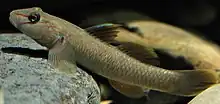Rhinogobius candidianus
Rhinogobius candidianus is a species of freshwater goby.[1][2][3] It is endemic to Taiwan.[1][2][4]
| Rhinogobius candidianus | |
|---|---|
 | |
| Scientific classification | |
| Domain: | Eukaryota |
| Kingdom: | Animalia |
| Phylum: | Chordata |
| Class: | Actinopterygii |
| Order: | Gobiiformes |
| Family: | Oxudercidae |
| Genus: | Rhinogobius |
| Species: | R. candidianus |
| Binomial name | |
| Rhinogobius candidianus (Regan, 1908) | |
| Synonyms[1][2] | |
| |
Etymology
The specific name candidianus refers to the type locality, Lake Candidius.[1][5] However, the species does not occur in the lake itself, but rather in the nearby rivers.[6]
Description
Rhinogobius candidianus can grow to 7.8 cm (3.1 in) standard length.[6][3] The body is elongated, compressed posteriorly. The dead is depressed with an obtuse snout tip. The pelvic fins are united to a rounded sucking disc. Body coloration is yellow or dark brownish. There can be 6–7 indistinct blotches on side; some adults have blue spots.[6]
Distribution and population structure
Rhinogobius candidianus is widely distributed in Taiwan. However, genetic data indicate that populations in the east and south of the island are likely resulting from introductions. Furthermore, genetic data show high population differentiation among the native populations, suggesting that this species has limited ability to disperse from one water course to another through the sea.[4]
Some sources suggest that this species also occurs in China,[3] but there is no evidence supporting this.[4]
Habitat and ecology
Rhinogobius candidianus occurs only in lotic habitats.[6] In the headwaters of Tamsui River, it is associated with microhabitats with large boulders and cobbles.[7] It is omnivorous and feeds primarily on filamentous algae, insects, and detritus;[8] another study characterizes its diet as mainly consisting of aquatic insects and macroinvertebrates (including freshwater crabs).[7]
References
- Eschmeyer, William N.; Fricke, Ron & van der Laan, Richard (eds.). "Rhinogobius candidianus". Catalog of Fishes. California Academy of Sciences. Retrieved 2 March 2023.
- Chen, I-Shiung. "Rhinogobius candidianus (Regan, 1908)". Catalogue of life in Taiwan. Biodiversity Research Center, Academia Sinica, Taiwan. Retrieved 2 March 2023.
- Froese, Rainer; Pauly, Daniel (eds.) (2022). "Rhinogobius candidianus" in FishBase. August 2022 version.
- Kang, Bin; Hsu, Kui‐Ching; Wu, Jui‐Hsien; Chiu, Yuh‐Wen; Lin, Hung‐Du & Ju, Yu‐Min (2022). "Population genetic diversity and structure of Rhinogobius candidianus (Gobiidae) in Taiwan: Translocation and release". Ecology and Evolution. 12 (8): e9154. doi:10.1002/ece3.9154. PMC 9366559. PMID 35979520.
- Christopher Scharpf & Kenneth J. Lazara (22 October 2022). "Order GOBIIFORMES: Family OXUDERCIDAE (p-z)". The ETYFish Project. Retrieved 2 March 2023.
- Chen, I. S. & Shao, K. T. (July 1996). "A taxonomic review of the gobiid fish genus Rhinogobius Gill, 1859, from Taiwan, with descriptions of three new species" (PDF). Zoological Studies. 35 (3): 200–214.
- Chuang, Ling-Chuan; Liang, Shih-Hsiung & Lin, Yao-Sung (2004). "Habitat use of two benthic fishes, Crossostoma lacustre and Rhinogobius candidianus, in the Hapen Creek of northern Taiwan" (PDF). Taiwania. 49 (3): 166–174. hdl:246246/161896.
- Wu, Min-yen; Hsu, Pei-yi & Chang, Shi-tsang (2010). "清水溪台灣特有種明潭吻鰕虎(Rhinogobius candidianus)攝食生態" [Feeding ecology of the endemic goby (Rhinogobius candidianus) in Chinshui Creek, Taiwan] (PDF). Taiwan Journal of Biodiversity (in Chinese). 12 (4): 367–380. doi:10.7064/TJB.201010.0367. (with an English abstract)